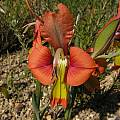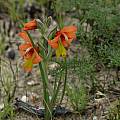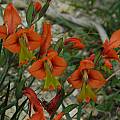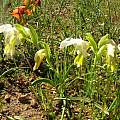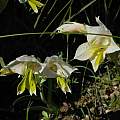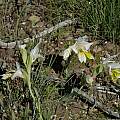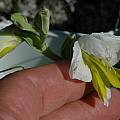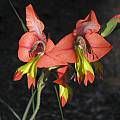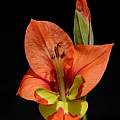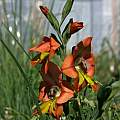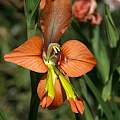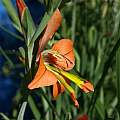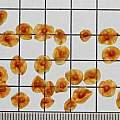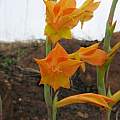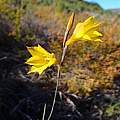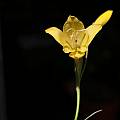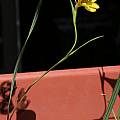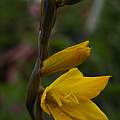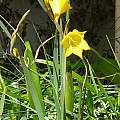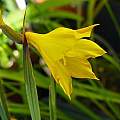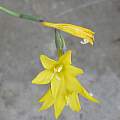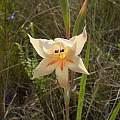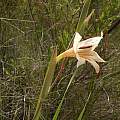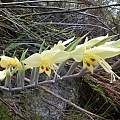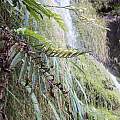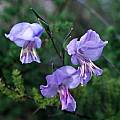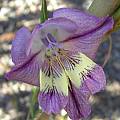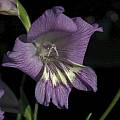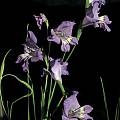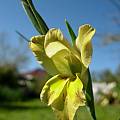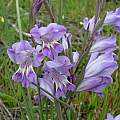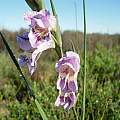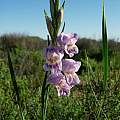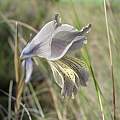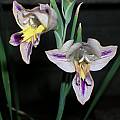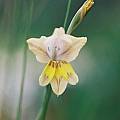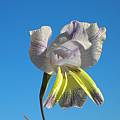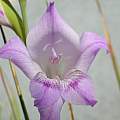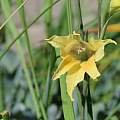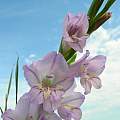Yellow may not be the first color that comes in mind thinking of Gladiolus, but there are some very striking species in this category. Quite often, there is a secondary yellow form of mainly orange or purple Gladiolus species.
Page 2: G. comptonii... Page 3: G. pardalinus... Page 4: G. woodii...
Gladiolus alatus L. is a winter rainfall species found on flats, slopes, and plateaus, mainly in sand. The flowers are orange, marked yellow and have a light and pleasant scent. Photo 1 was taken near Paarl September 2003 by Bob Rutemoeller. The next two pictures were taken by Bob Rutemoeller and Mary Sue Ittner near Bainskloof September 2006.
Photos below are a white form of this species. The first photo was taken by Alan Horstmann. The next two photos from Mary Sue Ittner and Bob Rutemoeller were taken near Villiersdorp. The last photo by Bob Rutemoeller shows a white form for sale in a nursery in Caledon.
The photos below are of plants in cultivation. Photo 1 by Mary Sue Ittner shows flowers on a plant grown from seed blooming March 2005. Photo 3 from Bob Werra. Photos 3-6 were taken by Nhu Nguyen. Photo 5 show seeds on a 1 cm square grid.
Gladiolus antholyzoides Baker is distributed across the central and eastern high veld of South Africa. Flowers are yellow, sometimes streaked with red or orange and with an orange ring around the throat. This species was once included in Antholyza as Antholyza laxiflora and Antholyza schlechteri, presumably because of its long perianth tube. It has also had other Gladiolus species names.
Gladiolus aurantiacus Klatt is found in the summer rainfall area often growing in high grassland and is centered in KwaZulu-Natal extending into Mpumalanga and Swaziland. Growing from 45 to 75 cm high, it has stem leaves with short blades and foliage leaves with longer blades that are produced on separate shoots near the end of flowering. The unscented flowers are yellow, dotted or streaked with red or orange which gives them the appearance of being orange borne on a 10 to 16 flowered erect spike. Flowers have an elongate flower tube, slender in the lower half. The dorsal tepal is slightly ascending to horizontal and the lower tepals with yellow blotches in the lower half curve sharply downward. Flowers are adapted for pollination by sunbirds. Flowering is unusual as it occurs early, mostly in September and October, before the main rainy season has started. Photo from Rachel Saunders.
Gladiolus aureus Baker is endangered. It is found in the wild today in only a single location, a peaty seep on a rocky sandstone slope in the Southwest Cape. There are reportedly as few as ten plants remaining at this location. It has bright yellow flowers. The first photo was taken by Rachel Saunders August 2012 at its only known locality. There were five flowering plants surrounded by alien vegetation, houses and destruction. Photos 2-4 were taken by Bob Werra and the last photo by Michael Mace.
Additional information and photos from Ernie DeMarie: I grew three plants from seed that was refrigerated for well over a decade that came from the annual seed distribution of the Botanical Society of South Africa, which unfortunately they no longer do for international members. This species is not self compatible so when all three plants bloomed I was able to cross them and set a good amount of seeds. I distributed seeds or young corms to growers in California, South Africa, Australia, and Argentina in the hopes that this species could be maintained in cultivation as it is gravely endangered at its one locality on the Cape Peninsula.
Gladious aureus is not especially difficult to grow under my conditions but corms can exhaust themselves if they set a lot of seed. It will usually flower the third year from seed. It appears to reproduce mainly by seed; thus far I have not seen evidence of abundant cormlet production as happens with most other gladiolus species. It blooms in February for me. Being a small plant it can be managed under lights more easily than many other gladioli species.
Gladiolus bilineatus G.J.Lewis grows in clay and loamy sand in the fynbos in the Langeberg Center (Southern Cape.) Growing from 20 to 40 cm and flowering March-April, this species has short sword shaped leaves and cream to pink flowers with reddish lines near the base of the lower tepals in a one to three flowered spike. Photos taken March 2016 near Swellendam by Rachel Saunders.
Gladiolus buckerveldii (L.Bolus) Goldblatt is a species restricted to a few sites along permanent rivers in the northern Cederberg of the western Cape. Plants grow out of nearly vertical moss covered cliffs. Growing from 80 to 125 cm, it has a horizontal spike of 12 to 20 ivory to greenish cream flowers, each with a spade or heart shaped dark red mark in the center of the lower tepals. It flowers in summer. In the past it was included in Antholyza as Antholyza buckerveldii because of its elongate floral tube (wide and cylindric above and slender below) and then was moved to Petamenes. In 1971 it was included in Gladiolus. Photos taken January 2014 by Rachel Saunders. It was growing on a cliff next to a waterfall.
Gladiolus carinatus Aiton is found on sandstone slopes or deep coastal sands in many areas of the Cape. It flowers late winter to spring and can be blue to violet or yellow, rarely pink, often with yellow markings on the lower tepals. The first two photos were taken by Mary Sue Ittner; the first photo was taken September 2001 in the Southwest Cape and the second shows the flower of a plant grown from seed and flowering March 2004. The next two were taken by Bob Werra. The last photo from Cameron McMaster shows a yellow form grown from seed by Rhoda McMaster.
The first five photos were taken in the Western Cape in Hopefield, Elands Bay, and near Napier by Cameron McMaster. The last photo is from Rod Saunders.
The photos from Alan Horstmann show different forms.
Gladiolus citrinus Klatt see Gladiolus trichonemifolius
Page 2: G. comptonii... Page 3: G. pardalinus... Page 4: G. woodii...
